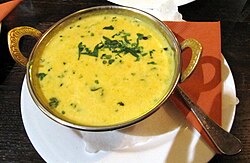Mulligatawny
 Mulligatawny as served in Mumbai | |
| Type | Other |
|---|---|
| Place of origin | India |
| Serving temperature | Hot, often with rice |
| Similar dishes | Rasam |
Mulligatawny [ˈmɐlɨɡəˈtɑːni] (![]() listen (help·info)) is a soup which originated from South Indian cuisine. The name originates from the Tamil words miḷagu (மிளகு 'black pepper'), and taṇṇi (தண்ணி, 'water'); literally, "pepper-water".[1] It is related to the dish rasam.
listen (help·info)) is a soup which originated from South Indian cuisine. The name originates from the Tamil words miḷagu (மிளகு 'black pepper'), and taṇṇi (தண்ணி, 'water'); literally, "pepper-water".[1] It is related to the dish rasam.
This recipe does not have a thick base. It is simply water boiled with spices, drumsticks, and herbs. It is also known as “Mulagacharu” in other parts of South India.
History[edit]
Mulligatawny was popular in India by the end of the 18th century,[1] and by the 19th century it began to appear in cookbooks of the day, with each cook (or cookbook) featuring its own recipe.[2] Recipes for mulligatawny varied greatly at that time and over the years (e.g., Maria Rundell's A New System of Domestic Cookery contained three versions), and later versions of the soup included British modifications that included meat,[3] although the local Madras (modern Chennai) recipe on which it was based did not.[4] Early references to it in English go back to 1784.[5] In 1827, William Kitchiner wrote that it had become fashionable in Britain:
Mullaga-Tawny signifies pepper water. The progress of inexperienced peripatetic Palaticians[lower-alpha 1] has lately been arrested by this outlandish word being pasted on the windows of our Coffee-Houses; it has, we believe, answered the "Restaurateurs' " purpose, and often excited John Bull, to walk in and taste—the more familiar name of Curry Soup—would, perhaps, not have had sufficient of the charms of novelty to seduce him from his much-loved Mock-Turtle. It is a fashionable Soup and a great favourite with our East Indian friends, and we give the best receipt[lower-alpha 2] we could procure for it.[6][7]
By the mid 1800s, Wyvern, the pen-name of Arthur Robert Kenney-Herbert (1840–1916), wrote in his popular "Culinary Jottings" that "really well-made mulligatunny is ... a thing of the past."[4] He also noted that this simple recipe prepared by poorer natives of Madras as made by "Mootoosamy" was made by pounding:
a dessert-spoonful of tamarind, six red chillies, six cloves of garlic, a tea-spoonful of mustard seed, a salt-spoonful of fenugreek seed, twelve black peppercorns, a tea-spoonful of salt, and six leaves of karay-pauk. When worked to a paste, he adds a pint of water, and boils the mixture for a quarter of an hour. While this is going on, he cuts up two small onions, puts them into a chatty, and fries them in dessert-spoonful of ghee till they begin to turn brown, when he strains the pepper-water into the chatty, and cooks the mixture for five minutes, after which it is ready. The pepper-water is, of course, eaten with a large quantity of boiled rice, and is a meal in itself. The English, taking their ideas from this simple composition, added other condiments, with chicken, mutton, &c., thickened the liquid with flour and butter, and by degrees succeeded in concocting a soupe grasse of a decidedly acceptable kind.[4][8]
In popular culture[edit]
Bengali writer Buddhadeb Guha's character Rijuda mentions it as his most hated soup.
In "The Soup Nazi" episode of Seinfeld, Kramer asks Elaine to get him a bowl of mulligatawny soup.
It was featured in the Homestar Runner cartoon Experimental Film with music written by They Might Be Giants.[9]
In Germany and Denmark, it is named in the English-language film sketch Dinner for One, which many people watch every New Year's Eve. As a result, "mulligatawny soup" (as it is called in the sketch) has achieved wide name recognition in Germany.
In Batman Vol 1. #701, it is revealed that mulligatawny soup is Batman's favourite food.
In George Orwell's novel A Clergyman's Daughter, it is referenced several times by a Cockney youth in the expression "That's the mulligatawny!" with a generally positive connotation.
See also[edit]
Footnotes[edit]
- ↑ "Palatician" may be a nonce word derived from "palate", in the sense of the ability to distinguish between and appreciate different flavours.
- ↑ "Receipt" is an old form of "recipe".
References[edit]
- ↑ 1.0 1.1 Clarkson, Janet (2010). Soup : a global history. London: Reaktion. p. 118. ISBN 978-1-86189-774-9. OCLC 642290114.
- ↑ Leong-Salobir, Cecilia (2011). Food Culture in Colonial Asia: A Taste of Empire. Abingdon, Oxon, UK: Taylor & Francis. p. 17. ISBN 978-0-415-60632-5.
- ↑ Dawe, W.H. (1888). The wife's help to Indian cookery : being a practical manual for housekeepers. London: Elliot Stock. p. 74.
- ↑ 4.0 4.1 4.2 "Wyvern" [Kenney-Herbert, Arthur Robert 1840–1916] (1885). Culinary Jottings. A treatise in thirty chapters on reformed cookery for Anglo-Indian rites, based upon modern English and continental principles with thirty menus (5 ed.). Madras: Higginbotham and Co. pp. 306–307.
- ↑ Yule, Henry (1902). Hobson Jobson (2 ed.). London: John Murray. p. 595.
- ↑ Kitchiner, William (1827). The Cook's Oracle; Containing Recipes for Plain Cookery on the Most Economical Plan for Private Families. Edinburgh: Cadell and Co. pp. 262–263.
- ↑ Roy, Modhumita (2010). "Some Like It Hot: Class, Gender and Empire in the Making of Mulligatawny Soup". Economic and Political Weekly. 45 (32): 66–75.
- ↑ Procida, Mary (2003). "Feeding the Imperial Appetite Imperial Knowledge and Anglo-Indian Domesticity". Journal of Women's History. 15 (2): 123–149. doi:10.1353/jowh.2003.0054. S2CID 143009780.
- ↑ "Experimental Film - Homestar Runner Wiki".
